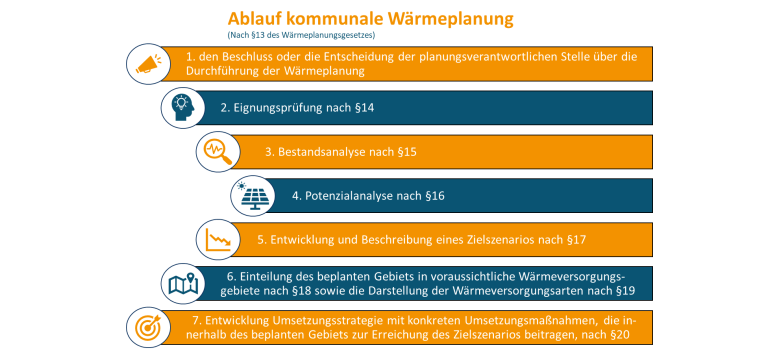Municipal heat planning
Municipal heat planning creates a coordinated basis for a greenhouse gas-neutral municipal heat supply by 2045. Until then, the municipal heat planning will be regularly updated in order to stay up to date both in terms of planning and technology.
The municipal heat planning for the pilgrimage town of Kevelaer was completed in December 2024. The results can be viewed in the final report . This overview map shows the possible heat supply areas.
Contents of municipal heat planning
According to the Heat Planning Act, municipal heat planning comprises seven sub-steps. Following a decision by the body responsible for planning, a rough suitability test is first carried out in order to exclude sub-areas for a specific type of heat supply. The current heating infrastructure is then recorded in the inventory analysis. In the potential analysis, all renewable potential for heat generation is analyzed. Based on the results, a target scenario for a greenhouse gas-neutral heat supply is then outlined, which, among other things, makes a building-specific division into suitable areas for grid-based heat supply, supply with green gases and individual supply. The implementation strategy describes measures with which the target scenario is to be achieved. A controlling concept and a continuation strategy are also designed to ensure compliance with the targets set out in the municipal heating plan.

Aim of municipal heat planning
The aim of the pilgrimage town of Kevelaer is to use municipal heating planning to support citizens in choosing their future heating supply. The debate surrounding the Building Energy Act ("Heating Act") has caused uncertainty and anxiety for many. Municipal heating planning is intended to help shed light on the situation, weigh up different heating supply options and provide guidance and a basis for planning for the coming years.
In addition to relevant stakeholders such as municipal utilities and regional energy suppliers, the public is also involved at an early stage and regularly informed about the progress of municipal heating planning, e.g. about the results of the inventory and potential analysis.
Furthermore, the feasibility of a district heating network in the municipal area is provisionally assessed in the municipal heating planning. The construction of a district heating network would offer citizens the prospect of a greenhouse gas-neutral heat supply and compliance with the requirements of the Building Energy Act.
Legal background
Municipal heat planning is required by law under the Heat Planning and Decarbonization of Heating Networks Act (WPG), which came into force on 1 January 2024. Municipalities such as the pilgrimage town of Kevelaer with fewer than 100,000 inhabitants* must draw up a heating plan by 30.06.2028 in accordance with Section 4 of the WPG.
Answers to frequently asked questions about municipal heat planning can be found under: FAQ Heat planning.
The Heat Planning Act is also linked to the amended Act on the Conservation of Energy and the Use of Renewable Energies for Heating and Cooling in Buildings (GEG). From January 1, 2024, every newly installed heating system in new buildings within new development areas must be powered by 65% renewable energy. For areas outside of new development areas and existing buildings, this rule will only apply after the deadline of June 30, 2028. It is important to note that this only applies to newly installed heating systems. Functioning heating systems may continue to run for the time being and defective heating systems may be repaired.
You can read the most frequently asked questions about the GEG here: FAQ GEG. You can find the entire GEG here.
Notes on choosing a type of heat supply
Until July 1, 2028 or until a possible designation of a heating network area for Kevelaer, citizens are legally entitled to install a fossil heating system. However, this is not necessarily the best financial decision for two reasons.
Firstly, all fossil fuel heating systems installed from 01.01.2024 onwards must gradually comply with certain blending obligations for renewable fuels (e.g. green gases or green heating oil) in their heating systems by 2045. From 2029, this proportion will be 15 percent, from 2035 30 percent and from 2040 60 percent. However, the availability and costs of these renewable fuels are currently very uncertain.
On the other hand, theCO2 price for fossil fuels will continue to rise. As of 01.01.2024, theCO2 price has risen to €45 per tonne, which means an additional charge of 0.816 cents for a kilowatt hour (kWh) of natural gas. In 2025, theCO2 price will be €55 per tonne and could rise to €65 in 2026. TheCO2 price will continue to rise significantly until 2045, so that according to forecasts theCO2 price could exceed the pure natural gas trading price in the future. The running costs should therefore be compared carefully.
The resulting additional costs for households can also be calculated using freeCO2 price calculators, for example from PIK and rwi or the consumer advice center.
The costs of measures for renewable heat supply can often be greatly reduced through subsidies. You can find an overview of free energy advice here .
When repairing or installing a gas heating system, tradesmen are obliged to provide advice.

